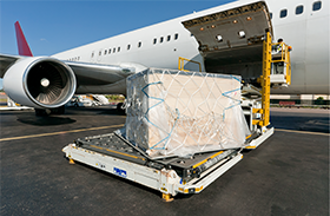
Translations:
Légère reprise de la croissance du fret aérien en avril, en hausse de 4,1 % (pdf)
El transporte aéreo de carga sube ligeramente 4,1% en abril (pdf)
Transporte aéreo de carga apresenta leve recuperação em abril, com crescimento de 4,1% (pdf)
国际航协:4月份航空货运需求小幅回弹 同比增长4.1% (pdf)
Sydney - The International Air Transport Association (IATA) released data for global air freight markets showing that demand, measured in freight tonne kilometers (FTKs), rose 4.1% in April 2018, compared to the same period the year before. This was up from the 1.8% growth in annual demand recorded in March 2018.
Freight capacity, measured in available freight tonne kilometers (AFTKs), grew by 5.1% year-on-year in April 2018. This was the second time in 21 months that capacity growth outstripped demand growth.
After a sharp fall in March 2018, to a 23-month low, global air freight volumes recovered slightly in April 2018. The pace at which demand is growing, however, remains significantly slower than in much of 2017.
The weaker growth in air cargo is primarily due to the end of the restocking cycle, during which businesses rapidly increase their inventory to meet unexpectedly high demand. This is consistent with demand drivers moving away from the highly supportive levels seen last year. The Purchasing Managers' Index (PMI) for manufacturing and export orders fell in April 2018 to its lowest level since 2016. A softening of global trade is also evident with containerized freight demand slowing in tandem with air freight demand. Seasonally-adjusted freight volumes continue to track sideways.
"April saw a strengthening from the abrupt slowdown in growth experienced in March. This is good news. We remain cautiously optimistic that demand will grow in the region of 4% this year. But the forecast appears to have increasing downside potential. Oil prices continue to rise as does protectionist rhetoric. Borders open to people and to trade drive economic growth and social prosperity. We are all disadvantaged when they are closed," said Alexandre de Juniac, IATA's Director General and CEO.
Regional Performance
All regions reported growth on 2017 levels, albeit at different levels of expansion.
Asia-Pacific airlines saw freight demand recover in April 2018 to grow 3.9% compared to the same period last year. Capacity increased by 6.7%. Seasonally-adjusted volumes are broadly trending sideways. As the largest freight-flying region, carrying close to 37% of global air freight, the risks from protectionist measures impacting the region are disproportionately high.
North American airlines' freight volumes expanded 3.2% in April 2018 compared to the same period a year earlier. This was a slight deceleration in demand from the previous month. Capacity increased by 3.4%. The weakening of the US dollar over the past year has helped boost demand for air exports. Data from the US Census Bureau shows an 11.7% year-on-year increase in air export volumes from the US in Q1 2018, compared to a slower rise in imports of 7.5%. More recently however, the US dollar has been rising.
European airlines posted a 2.4% increase in freight volumes in April 2018. This was over double the rate of growth of the previous month. Capacity increased 4.0%. Seasonally-adjusted volumes are broadly trending sideways. The strength of the Euro and a softening of export orders in Germany pose downside risks to European carriers.
Middle Eastern carriers posted the second fastest year-on-year growth in freight volumes in April 2018, up 7.3%. This was a significant acceleration in demand over the 0.8% recorded the previous month. The increase mainly reflects developments from a year ago rather than a substantive change in the near-term trend. Seasonally-adjusted freight volumes continue to track broadly sideways. This is consistent with signs of a broader moderation in global trade. Capacity increased 4.8%.
Latin American airlines experienced growth in demand of 10.6% in April 2018 - the largest increase of any region for the second consecutive month. Capacity decreased by 4.6%. The pick-up in demand over the last 18 months comes alongside signs of economic recovery in the region's largest economy, Brazil. Seasonally-adjusted international freight volumes are now back to the levels seen at the end of 2014.
African carriers saw freight demand grow 5.6% in April 2018 compared to the same month last year, after a decline of 3.4% in March. Capacity increased by 23%. After a surge in international FTK volumes last year, seasonally-adjusted international freight volumes have trended downwards from a peak in late-2017 and are now at levels seen mid-2017.
View full results in our April freight analysis (pdf)
For more information, please contact:
Corporate Communications
Tel:
+41 22 770 2967
Email: corpcomms@iata.org
Notes for Editors:
- IATA (International Air Transport Association) represents some 280 airlines comprising 83% of global air traffic.
- You can follow us at http://twitter.com/iata2press for news specially catered for the media.
- Explanation of measurement terms:
- FTK: freight tonne kilometers measures actual freight traffic
- AFTK: available freight tonne kilometers measures available total freight capacity
- FLF: freight load factor is % of AFTKs used
- IATA statistics cover international and domestic scheduled air freight for IATA member and non-member airlines.
- Total freight traffic market shares by region of carriers in terms of FTK are: Asia-Pacific 36.9%, Europe 24.2%, North America 20.6%, Middle East 13.7%, Latin America 2.7%, and Africa 1.9%.
